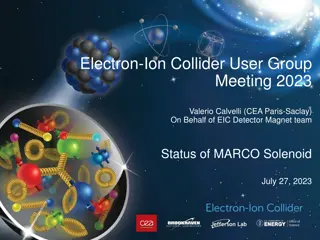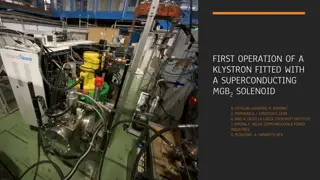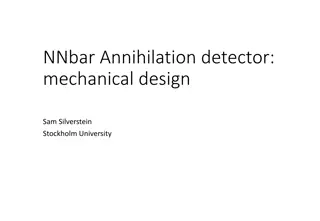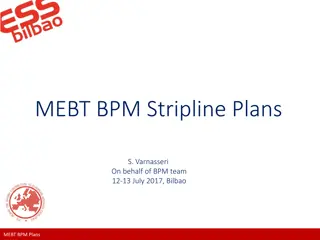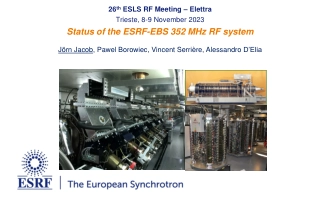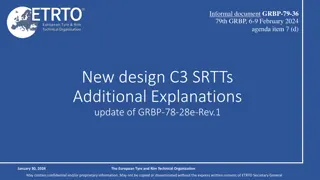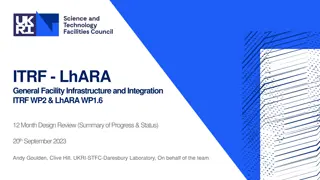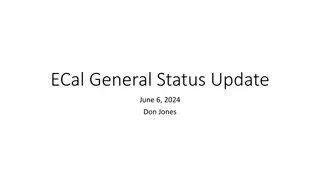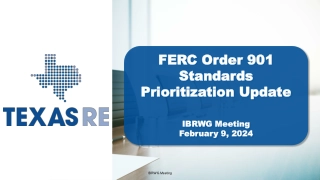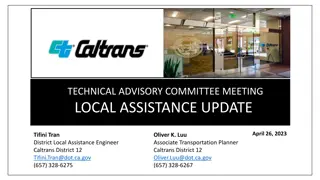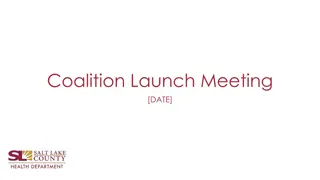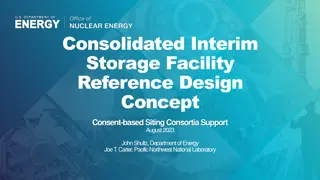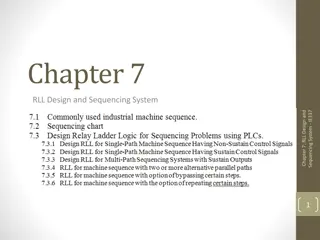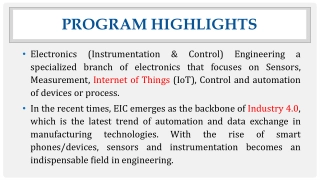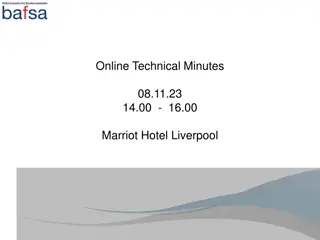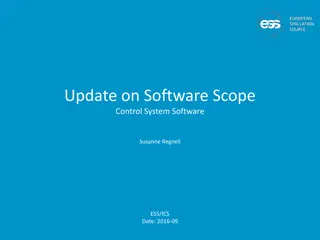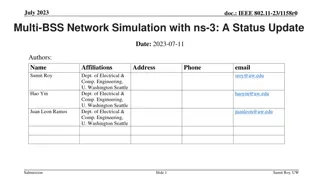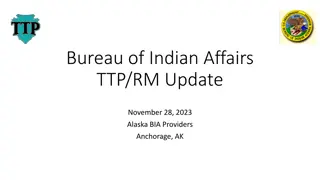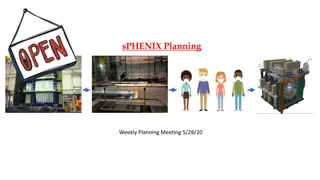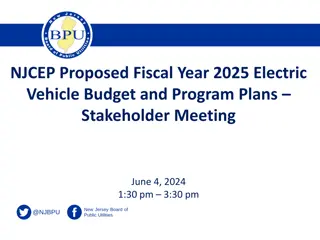Detector Solenoid Design Overview and Status Update for EIC UG Meeting
Overview of the detector solenoid design presented by Renuka Rajput-Ghoshal from JLab at the EIC UG Meeting. The presentation covers the team members, collaboration process, timeline, and milestones achieved in the design and procurement phases.
Download Presentation
Please find below an Image/Link to download the presentation.
The content on the website is provided AS IS for your information and personal use only. It may not be sold, licensed, or shared on other websites without obtaining consent from the author. Download presentation by click this link. If you encounter any issues during the download, it is possible that the publisher has removed the file from their server.
Presentation Transcript
Detector Solenoid Design Overview and Status Renuka Rajput-Ghoshal (JLab) EIC UG Meeting January 12, 2024
Outline Team Members How we work Timeline High Level View ePIC Detector Solenoid (MARCO) Overview Magnet Specification News from RRB News from the EIC Resource Review Board Magnet Assembly Magnetic Design Results Magnetic Circuit Conductor Definition, Conductor Margin, Mechanical, Cryogenic and Thermal Analysis Instrumentation Magnet Interface document Advance Procurement Plan Plans for 2024 Summary 2
Team Members JLab Renuka Rajput-Ghoshal, Probir Ghoshal, Eric Sun, Sandesh Gopinath, Dan Young, Rachel Reese and Kaiyi Hall- JLab Magnet Group Mitch Laney, Giuseppina (Jessie) Tenbusch, and DeAnn Maddox- Procurement Rolf Ent- Co-Associate Director for the Experimental Program, Detector Management CEA, Saclay Valerio Calvelli, Hugo Reymond, Michel Segreti, Jean-Pierre Lottin, Christophe Berriaud, Francesco Stacchi, Francois-Paul Juster, and Damien Simon Lionel Quettier- Resource manager and Expert Engineer BNL Rahul Sharma, Roberto Than, Alexander Kiselev, and Roland Wimmer Elke Aschenauer- Co-Associate Director for the Experimental Program, Detector Management 3
How we work Collaboration of Jefferson Lab, CEA Saclay and Brookhaven National Lab 30% Design done as in-kind contribution by CEA Saclay in collaboration with Jefferson Lab Magnet Group BNL provides subject matter expert information on infrastructure and integration 60% and 90% design done as contract with CEA Saclay augmented with Jefferson Lab work and further in-kind contributions of CEA Saclay. Expectation is that magnet construction follows a similar pattern for vendor oversight. Final design review committee also commented The collaboration between CEA-Saclay, JLab and BNL has continued to make excellent progress and the review committee strongly supports extending this collaboration into the procurement, fabrication and commissioning phases 4
Timeline CD-0 Approval December 2019 CD-1 Approval June 2021 Incremental (30%) Design and Safety Review February 2022 DPAP closeout report led to reduced field (< 3 T) March 2022 60% design team formation and kick off meeting May 3, 2022 60% Mid-Project Progress meeting June 28, 2022 Point design adjusted to stretch goal of 2 T August 10, 2022 60% Design and safety Review October 18, 2022 90% design contract with CEA, Saclay in place December 2022 Found qualified vendor willing to make conductor January 2023 Magnet RFI out March 2, 2023 Sample Conductor order April 14, 2023 90% Mid-Project Progress meeting April 18, 2023 Long Lead Procurement Review June 26, 2023 90% Design completion and review October 5-6, 2023 CD-3A Review November 14-16, 2023 5
High Level View Magnet Design is ready for long lead procurement, the two most important design parameters are conservative: large temperature margin and large critical current margin. Sample Conductor order is placed, and we located the possible sample conductor test facility. The conductor will be Government Furnished Item to the magnet manufacturing vendor. Magnet RFI was out last year in April, 5 responses received for magnet RFI, 2 response are very reasonable. 30% Design Review- February 23, 2022 Reviewers: Ruben Fair (PPPL) - Chair, Vladimir Kashikhin (FNAL), Gianluca Sabbi (LBNL) 60% Design Review- October 18-19, 2022 Reviewers: Ruben Fair (PPPL) - Chair, Vladimir Kashikhin (FNAL), Gianluca Sabbi (LBNL) Final Design Review - October 5 and 6, 2023 Gianluca Sabbi (LBL)- Chair, Ruben Fair (JLab), Vladimir Kashikhin (FNAL), William Schneider (JLab retired) FDR is 90% magnet design review, equivalent to 100% for Vendor Design-Build procurement) 6
ePIC Detector Solenoid (MARCO) Overview Superconducting Detector Solenoid 3.5 m long coil, 2.84 m room temperature bore diameter 2 T on-axis field Operating Temperature 4.5 K Conductor: Copper Cladded, Rutherford Cable made with NbTi superconducting strands Helium Return (Primary) Current Leads Helium Return (Redundant) Helium Supply Helium Supply (Primary) Helium Supply (Redundant) Instrumentation 7
ePIC Detector Solenoid Magnet Specifications Parameter Nominal Central Field at IP (T) Operating Field Range (T) Magnetic Field Polarity Coil length (mm) Warm bore diameter (m) Cryostat length (m) Cryostat outer diameter (m) Detector 1-Solenoid Comments Safe Operation 2 0.5-2.0 Bipolar 3492 2.84 <3.85 <3.54 To keep the same envelope as the existing BaBAR magnet 100 cm around center 80 cm radius 12.5 From z=+180 cm to 280 cm Flat Field area Field uniformity in Flat field Area (%) RICH area Projectivity in RICH Area (mrad@30GeV/c) Projectivity in RICH Area (T/Amm2) 1. Magnetic field properties 2. Stray field requirement is based on IR magnet location 0.1 10 <10 G @ z=-5.3 m, @z=+7.4 m, and @R=3.4 m 10 500 <150 >1.5 <30 2-3 3-4 Thermosiphon Cu Stabilized NbTi Rutherford cable 4.5 Stray field requirement Charging voltage (V) Fast discharge voltage maximum (V) Quench hot spot temperature (K) Temperature margin (K) Current margin (%) Charging time (hr) Cooldown time (weeks) Cooling scheme Conductor Operating Temperature 8
News from the December RRB Italy/INFN and France/CEA affirmed early December that the EIC detector solenoid magnet construction can be done as in-kind. Work has started on drafting the needed in-kind agreement documentation between JLab, Italy, and France. This agreement is with JLab as JLab will be responsible for accepting the magnet (in close collaboration with BNL subject matter experts). Model is that the conductor is provided as government- furnished equipment, Italy implements the magnet construction contract, and CEA and JLab continue their successful working model to provide the vendor oversight, quality assurance and testing. 9
Magnet Assembly Current Leads Current Leads Helium Phase Separator Cryostat Assembly Conductor and Current Lead exit currently being developed Chimney Final Chimney geometry and design TBD Chimney Components - In Work Thermal Shield Helium Return (Primary) Conductor, Plumbing and Instrumentation Exiting magnet and routing to Chimney Radial Tie-Rods Current Leads Helium Supply (Redundant) Helium Return (Redundant) Helium Supply Helium Supply (Primary) Instrumentation Axial Tie-Rods 10
Magnetic Design Results Coil is divided in 3 module Each module has 6 layers Parameter V7.6.2.2.10 3D Units Current 3924 A # turns 1668 B0 2.000 T Homogeneity 12.7 % Projectivity 3.28 Tmm /A Bpeak (MOD 3) 2.671 T Energy 45.010 MJ Inductance 5.846 H Magnet is 10 cm off center Fz MOD 1 11.88 MN Fz MOD 2 57.5 kN 3 modules are chosen, mainly Feasible single length conductor manufacture Ease of coil manufacturing Magnet quench protection Fz MOD 3 -11.97 MN Fz tot -32.4 kN Fr Tot 112 N Note: Mitigation of higher stray field on lepton is in progress, latest model B5300 <10G, verification is in progress B5300 15.3 G B7200 10.9 G B3400 2.4 G 11
Magnetic Circuit Any deviation from the above layout and simplifications must be approved by the responsible magnet engineers as subject matter experts before it can be implemented. Any addition of magnetic material in this layout must also be approved first. 12
Conductor Definition Rutherford cable: 20 =0.7 Nb-Ti strands Parameters Values Units Fiber Glass Insulation Solder mm Strand diameter 0.7 R~0.3 Cu/NbTi 1.3 (2.31) Strand 1.26 A Ic @ 2.6T & 4.7K > 680 6.78 4.6 m Filament diameter < 30 Copper RRR Cu > 80 11.4 NbTi strands 20 Cable 0.26 mm Transposition pitch 50 Dimensions are in mm Channel RRR Cu > 100 mm Copper section (Final) 43.7 Order of conductor samples put in place based on these specifications ! Working on sample conductor qualification Discussed with test facilities around the world Bid is out for sample test characterization Conductor is similar to the conductor used for 11.7 T MRI magnet at CEA, Saclay A Nominal current 3924 RRR conductor > 100 K Temp. margin @ 2.6T & 4.7K 2.5 Conductor K Hot spot Temperature 71.4 MPa 0.2% @ 293K > 165 km Unit length (supposed) 1.05 km Total length (supposed) 18.9 13
Conductor Margin @ 4.7 K B0 1.5 T 1.7 T 2.0 T Units Current 2942 3335 3924 A Top 4.7 4.7 4.7 K Bpeak 2.00 2.27 2.67 T > 1.5 K Temp. margin 3.06 2.82 2.45 K Robust and safe operating parameters Load line margin 59.6 54.2 46.1 % <30 % I / Ic(T,Bpeak) 17.9 22.1 29.3 % 5000 Jc @ 4.7K Load line B0 = 2T B0 = 1.7T B0 = 1.5T Bottura scaling law [1] 4500 4000 Parameters for the fit (C.R. Spencer) 3500 Bc20 Tc0 14.5 [T] 9.2 [K] 1.7 0.57 0.9 1.9 Jc[A/mm2] 3000 n 73000 [TA/mm ] C0 2500 2000 Ic degradation: 15% 1500 1000 Iseult conductor Ic degradation Cabling process <5% 500 Soldering process <5% 0 0 1 2 3 4 5 6 7 8 9 Bpeak[T] [1] Luca Bottura. A practical fit for the critical surface of NbTi. IEEE transactions on applied superconductivity, 10(1):1054 1057, 2000. 14
Mechanical Design 2D and 3D simulations were done on the overall magnet assembly, coils, mandrel and tie-rods. Analysis is done for Gravitational load Cool down Transportation load Seismic load Energization loads All the stresses, displacement are well within the acceptable limits. Radial tie rod Axial tie rod Vacuum vessel interface Bracket Cold ball joint Belleville washers Warm ball joint 15
Bottom view Cryogenics Design Top view Redundant cooling system to ensure thermosiphon working properly 2 thermosiphons (main + spare) 16
FEA Thermal Detailed analysis were performed that show the temperature gradient across coil and helium flow path is acceptable during: Operation Ramp up Cool-down Steady State and Transient analysis were completed Fluid density variation during operation was validated Magnet can be ramped to full field at 1A/s (total ramp up time 1 hr 15 minutes) Estimated time to cool down magnet from room temperature to operating temperature 8-10 days Current Ramp mode Coil Temp Cold mass Cross section Temp Two-phase flow Temp 17
Instrumentation I U1 U2 Voltage taps (eventually double for redundancy) 36 for the solenoids (18 DP) 4 for the busbars (2 DP) 4 for the current leads (2 DP) 2 for Utot (1 DP) 2 DCCT (1 for PS and one for magnet) 3 Heaters 2 Vacuum gages PT 100 thermal sensors: 10 on the thermal shield 6 on the current leads Flow meter: 2 for the current leads 2 to 4 for the thermosiphons inlet and outlet 2 for the 50 K shield inlet and outlet 2 He level gages 2 Manometer (pressure sensor) One load sensor by tie-rods CERNOX thermal sensors: 12 distributed on the magnet and the shell 6 on the phase separator and thermosiphon inlet and outlet U3 Solenoid Utot U20 U22 U21 Magnet is well instrumented with proper redundancy in instrumentation 18
Magnet Interface document Prefix I SubSystemID DET-MAG Entity Index 1 InterfaceID I-DET-MAG.1 Type MECH RelatedSystemID DET-INF-MECH InterfaceName External Support Structure Description Total weight of the solenoid and all embedded components must be supported. The LCW water cooled leads will need to be fully supported along their path between the electrical room and the magnet. Cryogenic connection must be as close as possible to the source, and have a flexible line allowing the magnet to be moved between the Hall and the maintenance area while still connected. The maximum size of the solenoid is limited to the interior bore of the barrel hadron calorimeter and necessary support structures. The maximum backward location for the solenoid is limited by the position of the Lepton Direction Hadron Calorimeter and the associated cabling plenum between them. I DET-MAG 2 I-DET-MAG.2 SPACE DET-INF-SPACE LCW Connection I DET-MAG 3 I-DET-MAG.3 SPACE DET-INF-SPACE Cryogenic Connection Point I DET-MAG 4 I-DET-MAG.4 SPACE DET-HCAL-BAR External Space Contraint I DET-MAG 5 I-DET-MAG.5 SPACE DET-HCAL-BCK Backward Space Constraint I DET-MAG 6 I-DET-MAG.6 SPACE DET-PID-FWD Forward Space Constraint The maximum forward location for the spolenoid is limited by the position of the Dual RICH detector and the associated cabling plenum between them. The interior radius of the solenoid is limited by the size of the barrel Electromagnetic Calorimeter and its support system. An ice management system will be required to melt accumulated ice on the chimney. (Water should evaporate and will not require drainage) A boundary must be established to identify the extent of the magnet's stray field during operations. No detectors or components constructed with magnetic material may be added to the detector without prior consultation with the magnet group. The power supply, located in an adjacent electrical room, will need to be cooled with low conductivity water. The solenoid will require a continuous flow of cryogens to maintain temperature in both the experimental hall and the maintenance area. Interface includes cryogenic source and warm return. Solenoid will be provided power via the power supply located in an adjacent room. The instrumentation rack for the solenoid will require backup/UPS power adequate to safely shutdown the system in the event of a power failure. Control cabling for the magnet instrumentation will be run from the solenoid to the instrumentation rack on the carriage. Live monitoring data from the solenoid's operation must be recorded and maintained for diagnostic purposes. All subordinate detectors are dependent on the continous operation of the solenoid and on the delivery of a consistent, stable magnetic field. DET-ECAL-BAR Note that all magnet interfaces are presently frozen. This is required to start the construction contract. Any change in interface needs now to follow a sign- off process by the magnet team and others. I DET-MAG 7 I-DET-MAG.7 SPACE Interior Space Constraint I DET-MAG 8 I-DET-MAG.8 ENV Ice Management I DET-MAG 9 I-DET-MAG.9 ENV INF-SPACE Fringe Field I DET-MAG 10 I-DET-MAG.10 ENV DET Magnetic Material I DET-MAG 11 I-DET-MAG.11 COOL DET-INF-COOL-LCW Power Supply Cooling I DET-MAG 12 I-DET-MAG.12 CRYO DET-INF-CRYO Magnet Cooling I DET-MAG 13 I-DET-MAG.13 ELEC DET-INF-ELEC Electrical Power I DET-MAG 14 I-DET-MAG.14 ELEC DET-INF-ELEC Instrumentation Backup Power I DET-MAG 15 I-DET-MAG.15 CONTROL DET-COMP-ONLINE Controls and Instrumentation I DET-MAG 16 I-DET-MAG.16 DATA DET-COMP-ONLINE Monitoring Data I DET-MAG 17 I-DET-MAG.17 PARAM DET Magnetic Field Requirement 19
Advance Procurement Plan According to current APP Magnet Contract is awarded by Mid-July 2024. Plan is to keep the same schedule with INFN Complete magnet system delivery date according to the project plan is August 2029 20
Plans for 2024 Working on implementing local measures to further reduce fringe field, Finalize the sample conductor testing plan and facility, award contract Finalize the Final Magnet Design Report Finalize the reference drawings for the magnet Finalize Acceptance and quality plan for the magnet Final design review for Magnet power supply (tentatively April 2024)- Magnet power supply is being considered to be included in CD-3B package Initiate the magnet construction phase (August 2024) Finalize documents for the overall conductor procurement (June 2024) 21
Summary and What Next Magnet design to initiate vendor design-built contract is complete. Magnet RFI was done in April 2023, received 5 responses, 2 responses looks very reasonable. Working on the final design report and quality documents to initiate procurement. Sample conductor order was placed 04-21-2023 Sample conductor qualification work is progressing well. 22
Questions? 23
ESH &Q- Electrical & Pressure Vessel Magnet Power supply, electrical and Instrumentation feedthroughs will comply as per 6210 Electrical Safety Manual NFPA 70E, 2015 - Standards for Electrical Safety in the Workplace National Electric Code (NEC) Handbook DOE HDBK-1092, 2013 Department of Energy Electrical Safety Handbook ES&H Manual 6230 Electrical Safety Manual JLAB-6220 AC Electrical Equipment Safe Work Program All the vessel are designed according to the requirements of ASME codes Pressure piping is governed by ASMEB31.3 24
FMEA Focused on the following categories: a. Magnet design - Electro-magnetic, electro-mechanical, magnet protection, magnetic field mapping b. Mechanical design coil manufacturing, tooling, magnet or coil assembly, alignment, coil support and magnet support structure, vacuum, pressure, Cryo-thermal design and safety c. Electrical design electrical insulation, power requirements, electrical faults and safety d. Controls - instrumentation, interface with other sub-systems, firmware, software, hardware, and electronics Total number of risks identified for analysis for the categories are- a. Magnet design - 41 b. Mechanical design - 51 c. Electrical design - 44 d. Controls 28 25
Quench Analysis Single coil quench analysis Single coil quench analysis shows hot spot temperature and maximum temperature well below the accepted limits MIITS calculations were done with and without dump resistor, with dump resistor magnet is in safe quench limits. The transient analysis shows the effect of mandrel in quenchback Quench Analysis was also done using COMSOL 26


